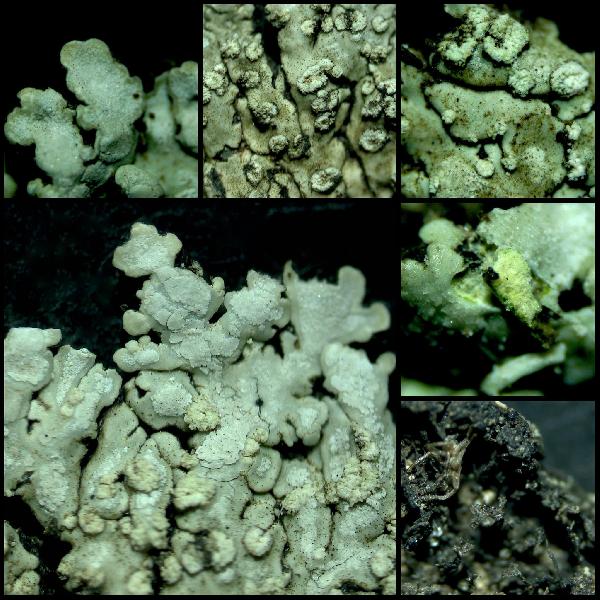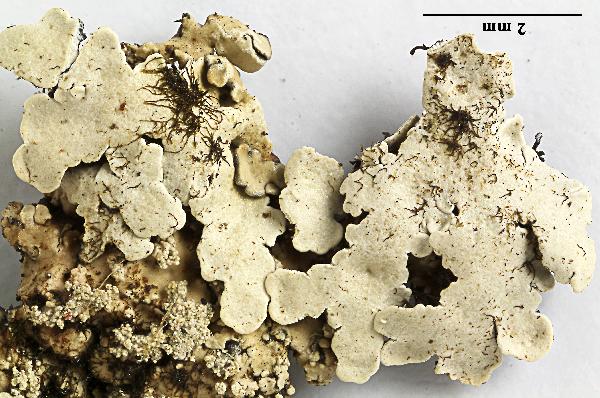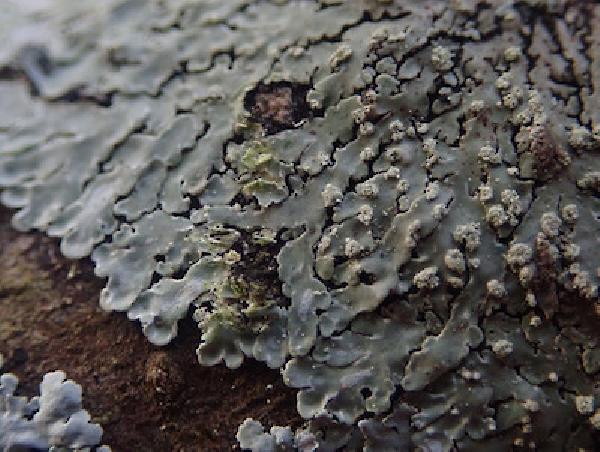Pyxine subcinerea Stirt.
Trans. Proc. N. Z. Inst., 30: 397, 1898.
Synonyms: Pyxine chrysantha Vain.; Pyxine chrysanthoides Vain.
Distribution: N - Lig (Castello & al. 1994, Brunialti & Giordani 2000, 2003, Modenesi & al. 2001, Giordani & al. 2001, 2002, 2003b, Benco & al. 2004, Ravera & Giordani 2007, 2008, Giordani & Incerti 2008, Ravera & al. 2021c). C - Tosc (Giordani & al. 2009, Benesperi & al. 2013), Laz (Massari & Ravera 2002, Ravera & Giordani 2007, 2008).
Description: Thallus foliose, heteromerous, dorsiventral, rather firmly attached, sorediate, forming orbicular, 3-5(-8) cm wide rosettes. Lobes flat to slightly concave, 0.3-0.6 mm wide, grey to brownish grey, sometimes pruinose (the pruina forming distinct patches), rarely with a faint network of laminal, linear pseudocyphellae, with initially marginal, fissural, later laminal, orbicular, convex soralia; soredia farinose. Lower surface black in central parts, paler at margins, with black, furcate rhizines. Upper cortex paraplectenchymatous; medulla lemon-yellow to creamy yellow in upper part, white in lower part; lower cortex prosoplectenchymatous. Apothecia lecideine, very rare (not seen in Italian material), laminal, 0.3-1.5 mm wide, with a black, epruinose disc, without a distinct thalline margin. Internal stipe poorly developed, brownish-red and K+ purple in upper part, paler and K- in lower part; proper exciple blackened; epithecium bluish black, K+ purple; hymenium colourless; paraphyses capitate; hypothecium brown. Asci 8-spored, clavate, Bacidia-type. Ascospores 1-septate, brown, ellipsoid, 13-19 x 6-8 µm. Pycnidia black, immersed. Conidia bacilliform, 3-4 x c. 1 µm. Photobiont chlorococcoid. Spot tests: upper cortex and medulla K-, C-, KC-, P-, UV+ yellow. Chemistry: upper cortex with lichexanthone; medulla with terpenes and an unknown pigment. Note: a subtropical species, esclusively Turrhenian in Italy; the Italian records are from Olea and Cupressus. For further details see Masson & Bauvet (2021). It is included in the Italian red list of epiphytic lichens as “Vulnerable” (Nascimbene & al. 2013c).
Growth form: Foliose, narrow lobed
Substrata: bark
Photobiont: green algae other than Trentepohlia
Reproductive strategy: mainly asexual, by soredia, or soredia-like structures (e.g. blastidia)
Restricted to humid-warm, oceanic areas
Commonnes-rarity: (info)
Alpine belt: absent
Subalpine belt: absent
Oromediterranean belt: absent
Montane belt: absent
Submediterranean belt: absent
Padanian area: absent
Humid submediterranean belt: absent
Humid mediterranean belt: very rare
Dry mediterranean belt: absent

Predictive model
Herbarium samples
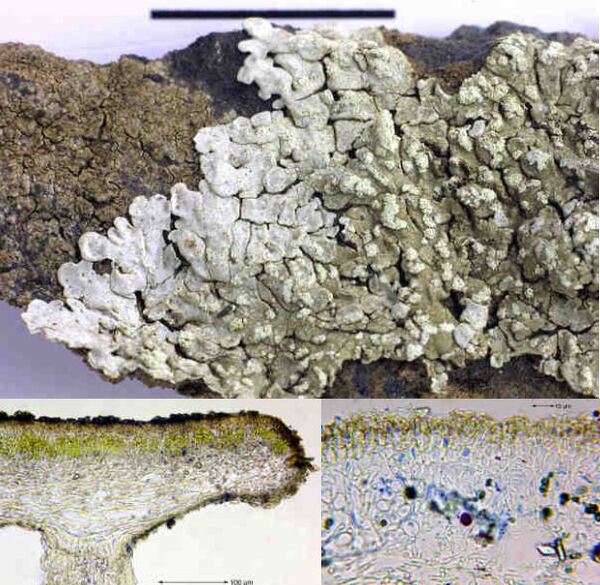

Felix Schumm – CC BY-SA 4.0
Image from: F. Schumm (2008) - Flechten Madeiras, der Kanaren und Azoren. Beck, OHG - ISBN: 978-3-00-023700-3
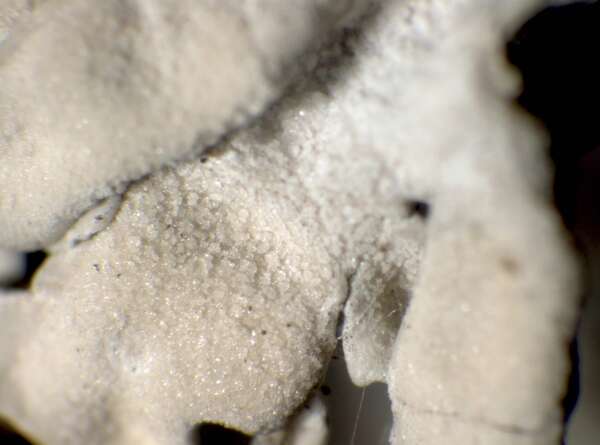

P.L. Nimis; Owner: Department of Life Sciences, University of Trieste
Herbarium: TSB (34306)
2001/12/11
detail of upper surface with pruina
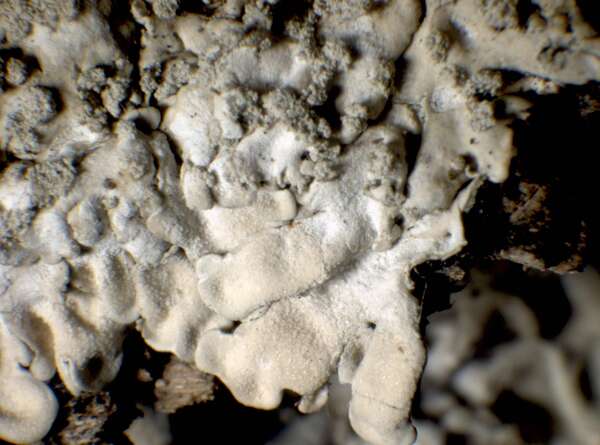

P.L. Nimis; Owner: Department of Life Sciences, University of Trieste
Herbarium: TSB (34306)
2001/12/11
Growth form: Foliose, narrow lobed
Substrata: bark
Photobiont: green algae other than Trentepohlia
Reproductive strategy: mainly asexual, by soredia, or soredia-like structures (e.g. blastidia)
Restricted to humid-warm, oceanic areas
Commonnes-rarity: (info)
Alpine belt: absent
Subalpine belt: absent
Oromediterranean belt: absent
Montane belt: absent
Submediterranean belt: absent
Padanian area: absent
Humid submediterranean belt: absent
Humid mediterranean belt: very rare
Dry mediterranean belt: absent

Predictive model
| Herbarium samples |


Felix Schumm – CC BY-SA 4.0
Image from: F. Schumm (2008) - Flechten Madeiras, der Kanaren und Azoren. Beck, OHG - ISBN: 978-3-00-023700-3


P.L. Nimis; Owner: Department of Life Sciences, University of Trieste
Herbarium: TSB (34306)
2001/12/11
detail of upper surface with pruina


 INDEX FUNGORUM
INDEX FUNGORUM
 GBIF
GBIF

